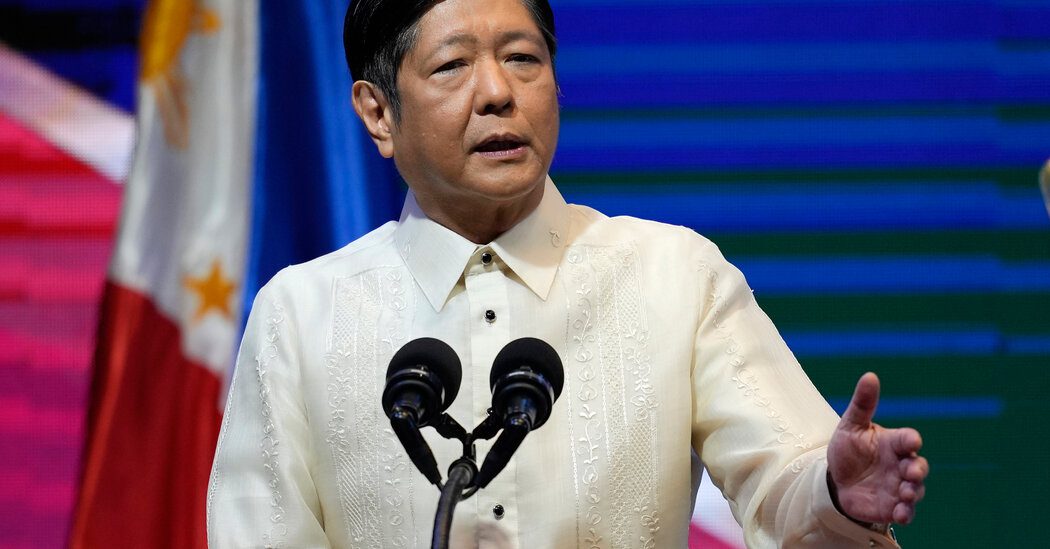Global Courant 2023-05-01 23:06:20
President Biden meets with President Ferdinand Marcos Jr. on Monday. of the Philippines at the White House, part of a four-day US visit by Mr. Marcos, intended to herald a stronger alliance between the two countries.
The pair will discuss efforts to “uphold international law and promote a free and open Indo-Pacific,” according to a statement. Statement from the White Housedue to heightened concerns about China’s growing assertiveness and fear of conflict over Taiwan, disputed seas, islands and shipping lanes.
Former President Rodrigo Duterte of the Philippines has been more conciliatory than his predecessors towards China and at times more confrontational with the United States. Mr. Marcos, elected last year, has moved closer to Washington.
Here’s a brief overview of the relationship between the United States and the Philippines, which have a long-standing close — if sometimes unstable — relationship:
Are the US and the Philippines allies?
The Philippines, the oldest U.S. treaty ally in the Asia-Pacific region, has long been a strategic anchor for U.S. influence and military might in the Western Pacific, but it’s a relationship complicated by historical grievances.
In the Spanish–American War of 1898, the United States won control of the Philippines from Spain, which had ruled the archipelago for centuries. US troops then brutally suppressed a Philippine independence movement, in a war largely forgotten in the United States, but not in the Philippines.
Japan invaded the islands in World War II and Americans and Filipinos fought together to end that occupation. The Philippines gained independence in 1946 and signed a mutual defense treaty with the United States in 1951.
During the Cold War, the United States had two of its largest overseas military installations in the Philippines, Clark Air Base and Subic Bay Naval Base, both of which closed in the 1990s. The United States also supported the autocratic 20-year rule of Ferdinand Marcos, father of the current president.
The US military presence has long been a source of tension in the Philippines, where many people view it as an unwanted legacy of colonial rule. But a 1999 agreement allowed large-scale military exercises by visiting forces and a 2014 agreement allowed extended stays of US troops at five locations in the Philippines.
Relations deteriorated under Mr. Duterte, who moved closer to China and waged a harsh war on drugs at home, with a spate of extrajudicial killings. Mr. Duterte threatened to push back against the US military presence, though he ultimately took no action.
Since taking office 10 months ago, the younger Mr. Marcos has sought to strengthen ties with the United States.
Why is this meeting important?
The US is strengthening its military position in the Asia-Pacific region to counter China’s military expansion there and prepare contingency plans in case China invades Taiwan, the democratic island that China has claimed as its territory.
US officials have identified the strategically located Philippines as crucial to warding off potential conflict. The country’s northern main island, Luzon, is just 360 kilometers south of Taiwan.
For their part, Philippine officials want the United States to help them deter China from using its military weight to invade its disputed sea territory.
That tire resurgence seemed to be strengthening in recent months. In February, Manila signed a new agreement that would allow Washington to increase the US military presence, and Mr. Marcos personally attended the largest joint military exercise between the two countries to date in April.
Just two days ago, the United States accused Beijing of harassing and intimidating Philippine security ships. The Ministry of Foreign Affairs appealed to China to “refrain from his provocative and unsafe behavior.” An armed attack against Philippine ships or military forces, the department warned, “would invoke U.S. mutual defense obligations.”
What territorial disputes does the Philippines have with China?
The Philippines is among a group of Asian countries embroiled in long-standing disputes with China over territory in the South China Sea, an area the size of Mexico that includes busy trade routes, rich fishing waters and strategically important maritime zones.
Beijing has claimed historic rights to much of the sea and has stepped up its naval patrols; take control of small reefs and islands also claimed by the Philippines; and building artificial islands and airfields and placing military outposts there. Manila says Chinese naval patrols harassed and chased away Philippine military and fishing vessels.
In 2016, an international tribunal in The Hague rejected China’s claim over the sea, saying it violated international law.
But former President Duterte, who has called diplomacy with Beijing a “delicate balancing act”, strongly objected to pushing President Xi Jinping to comply with the ruling, warning his country could not afford trouble with China.
That position ran counter to public opinion in the Philippines: Polls late last year showed that 84 percent of Filipinos believe the Marcos government should work with the United States to defend their sovereignty in the disputed waters.




